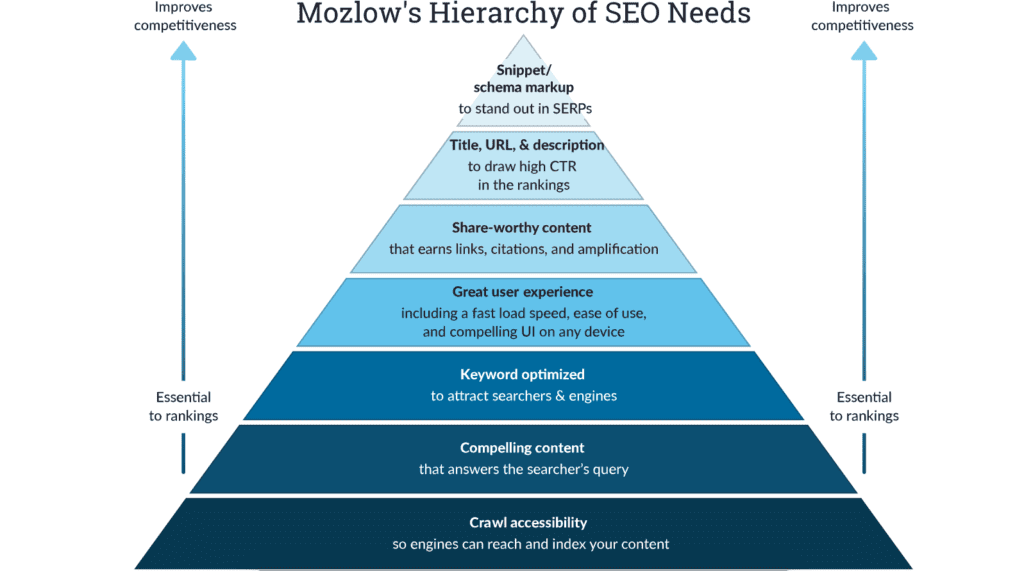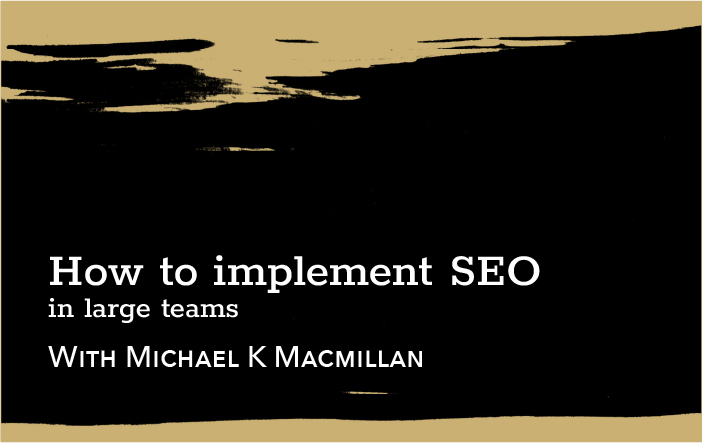‘How to Implement SEO with Large Teams’ with Michael MacMillan was recorded at our SEO Brunch in April 2021
For as long as he can remember, Michael has been curious about why things rank. Since 2009, all his job titles have included SEO, ranging from in-house to leading an agency SEO team. As a consultant, he empowers teams to consider organic search in all strategies. Michael knows his stuff, and he will help your team improve your SEO game.
Not every marketing team, no matter how big the team is, has in-house SEO. But, that doesn’t mean they can’t consider SEO during their development.
We like to use the Hierarchy of SEO needs.

As you can see, there are seven subcategories. The bottom is your foundation, you want that to be solid, and it builds from there.
What we’ve found is different internal teams can own aspects of this. It is always helpful to have somebody in a leadership role with SEO because much of it is just making sure all the pieces are working together and not overlapping. And that best practices are followed.
Crawl Accessibility
So the first level, crawl accessibility, is how engines can reach and index your content.
This task often gets lumped into classical technical SEO. If you were at the last SEO brunch, we had brilliant technical SEO, Jason Logan, join us. Who really owns this space, and he comes from a web development background. What I’ve found, especially working in agency spaces, is a lot of this work is just generally good practices. Most web developers, if they’re not aware of it, should be.
When I work with more robust companies, they usually have a marketing engineer or a third-party web development team. They should own this aspect, but they might need some initial direction.
You can use tools like Ahref’s Site Audit to get an idea of how things are functioning. If you want to go deeper, you can look at stuff like DeepCrawl or SEMrush. Most of the main tools have a site audit tool.
You can also look in Search Console to see if there are issues with indexing the site. If there are, this is a solid foundational piece the technical team can own.
Compelling Content
Now compelling content, this comes down to your writers and your PR team. Your PR team is probably pushing stuff to get brand awareness out. At the same time, the content team is likely developing content around peripheral subjects. Like the questions people ask about your main product or service. So, your content team, your writers, they’re the ones that can own the compelling content.
Now, they need to understand things like keyword research. What is already performing? They should be looking in Search Console to see what’s turning into traffic—and looking to analytics to see if that traffic’s converting. But a lot of that can be handled by the content team.
Keyword Optimization
Next up is keyword optimization. Another task able to be handled by the content team. Now, sometimes writers don’t want to focus on optimization, but you could have a dedicated person on the team who understands how that works who optimizes content before publication. For example: adding unordered or ordered lists so the user can jump through.
There’s also the potential of getting many site links, making sure the title and description are compelling and include keywords. These actions can be led by someone on the content team or somebody just very content-minded who understands other aspects of how the site performs.
At that point, there might be aspects they don’t understand. Maybe you keep changing the title, but it doesn’t recognize the change. These are the kinds of things to bring back to your developer.
Great User Experience
A great user experience is something that gets owned by a lot of different people. If you have an in-house use UX team, that’s great. Then they’re the team who own this piece. But there are a lot of parts and people involved. There are content people, designers, developers (somebody has to implement when ready to go).
A great user experience should be owned by all teams but spearheaded by UX.
Shareworthy Content That Earns Links, Citations and Amplification
So this is your backlink builders. This work can be led really well by social media and community management teams. The people paying attention to Reddit or any other forum channels where your brand appears.
You can use tools like If This Then That (IFTTT). If you haven’t played with it, I highly recommend it. Or you can set up these listeners that listen on Reddit and record every time somebody mentions your product or your brand, or even your service offering. However, you might get a little bit bombarded with notifications if your service offering is something common like web design. But if you want to get a little bit more niche, you can really dig into that.
Title, URL, & Description to Draw Higher Click-through Rates
This work falls back to that person on the content team, the one who can go back and review. It’s great to come up with new content. But a lot of times, companies have content that’s just sitting on the cusp of things. Striking distance is a term we use a lot. It refers to anything that registers lower than the middle of the first page through the second in search results.
What’s cool about that is it means all the signals are there for Google. It’s just not in a place where it converts yet. So if you can draw the eye, if you can change the title to be a little bit more keyword-focused, a little bit more compelling, and draw people to click through with time, you’ll start creeping up in the search results.
Snippet/schema Markup to Stand Out in SERP
Another technical task. But I would talk to your web developers or your marketing engineer to get a system in place or vet a solution. Then that same person managing the posting and refinement of content can test to see if this type of content is performing.
So, that’s how we like to structure our work with other teams. A lot of these companies don’t have in-house SEO, but they understand the importance. And they have the resources. With a little bit of direction, they can own these aspects of SEO.

